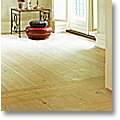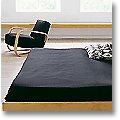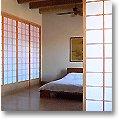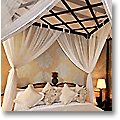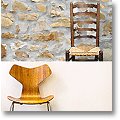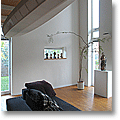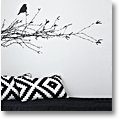Zen Interior Design: The DOs & DON'Ts
Of Zen Design & Zen Decorating
'Zen interior design' means different things to different people. For Asian-inspired rooms and zen interiors, click a pic:
To some people, a Zen aesthetic is all about clear, open (even empty) spaces, featuring concealed storage and minimal decoration. Others believe that Zen interiors must have a Japanese touch - either traditional or contemporary.
In A Nutshell:
Elements Of Zen Interior Design
The overall goal of Zen interior design is to create a peaceful, inspiring home that looks good without looking dressed up. (Here are some photos!) To create the look, combine any or all of the following elements of Zen decorating:

♦ Clean straight lines: nothing that's visually busy;
♦ Built-in, concealed storage;
♦ Open, clear spaces (zero clutter);
♦ Natural, beautiful but unfussy materials;
♦ Quality but simple furnishings: nothing 'bling' or high-maintenance, nothing that screams for attention or tries to impress;
♦ Low-impact colors taken from nature, a minimum of (subtle) pattern;
♦ Quality rather than quantity;
♦ A calm overall look (you get enough stimulation when you step outside the front door ;-)
In A Nutshell: Zen
Most people know very little about the historic and philosophical roots of Zen interior design. Here's a sixpence tour of Zen:
What Zen Is
Zen is a style of Buddhist spiritual practice. It is sometimes called a 'teaching' or a 'philosophy', but its core is the practice.
As a Zen practitioner, here's what you do:
1. Throughout your daily life and work, you cultivate a calm, clear, pure, wide open attitude of mind.
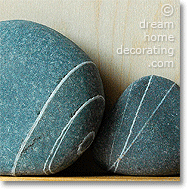
2. You practice conscious awareness, with mind and body, in everything you do - all day long. (They say it gets easier once you really get into it!)
3. You practice loving kindness toward all beings (not just the human ones).
4. You meditate in the zazen style, sitting quietly, emptying your mind of thoughts (memories, plans, opinions) and focusing on your breathing.
It's a lifelong quest, and there is much more to it than this - but since you're here for Zen interior decorating and Zen design, let's stick to the ultra-quick shortcut version.
But Is It Japanese?
Not necessarily. The word 'Zen' is Japanese, and the first Zen teachers that came to the West were Japanese. But the practice originated in China, about 1500 years ago (it was called Ch'an). With the expansion of Buddhism it spread to Vietnam, Korea, Japan, later to Europe and the USA, and is now practiced in many parts of the world.
Applying Zen principles to home decorating is, of course,
a very good idea, and lots of people are doing it. So here's how you get from Zen as a spiritual practice to Zen interior design.
How To Apply 'Zen' To Interior Design,
Step By Step
1. Calm, clear, pure, wide open - you can create these qualities in your home as well as your mind. (In fact, creating them in your home will help you create them in your mind.)
The purpose of decorating Zen style is to turn your home into a sanctuary, a soothing, tranquil place of respite from the rush and emotional demands of the outside world. Here's how to "do" basic Zen interior design:
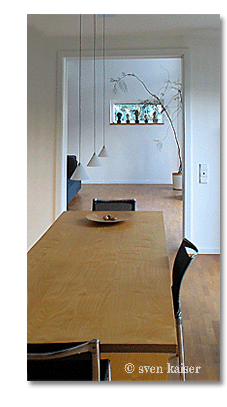
♦ Reduce the color palette to calm, 'quiet' colors (like neutrals, water and earth tones).
◊ Not sure how to use neutrals? Download my free e-book!
♦ Gradually take away all clutter, including ...
◊ small decorative items (even if they're pretty, they count as visual 'clutter')
◊ things you don't actually use
◊ things with an obvious pattern
◊ area rugs (particularly if they're colorful and eye-catching)
♦ Clear all surface spaces (walls, floor, tables and other furniture) as much as you possibly can. (More about this on the page about Zen Decorating!)
Looking at this list, you might find that Zen interior design
is a fairly radical concept. But it doesn't have to be. You could, for example, start with one area, even a very small one; if you have a home office, it could just be a part of your desk.
Decide that nothing is going to encroach on this free space. It holds no things that could demand your attention - just a clear, calm, empty space to rest your eyes on.
Any part of your home could become an experimental Zen decorating zone like that: a hallway table, a sideboard or coffee table, an empty wall painted in a pure, 'translucent' color.
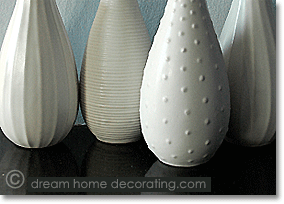
2. Conscious awareness.
To give you a very rough idea of the experience, here is a 'non-Zen' example:
I remember how my Dad once had to go on a low-salt diet. After two weeks of no added salt, he said ...
"Now I'm beginning to appreciate what this food really tastes like, the nuances, the subtle flavors. I eat less and enjoy it more. I don't think I'll ever want salt again."
Reducing the decor in your home can have a similar effect. The less there is to stimulate your senses, the more you will notice what is there, and how it affects you. Which brings me to the next aspect of Zen interior decorating ...
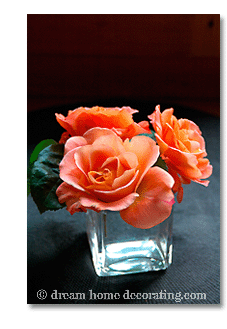
3. Loving kindness. Some people think that Zen interiors have to be sparse and spartan, that it's about denying yourself creature comforts.
But that's not how I understand it. You could express loving kindness through the materials you use, and the things you surround yourself with.
- Are they pleasing to the senses?
- Is your furniture comfortable?
- Do you feel at ease with the things around you? Do they feel welcoming to others?
I don't think Zen interior design is about living in empty rooms. It's about creating true well-being, for body and soul.
4. Meditation, therefore, can have a place in Zen interior design as well - and it doesn't need to be zazen. One way to focus and calm your mind is to place a picture or a natural object as a focal point in a room, and surround it with plenty of empty space. Here are some good candidates for Zen interior decorating (the fewer & simpler the better):
- a seriously gorgeous pebble
- a piece of driftwood
- a flower
- a picture of a waterfall
- a seascape ...
All these can work beautifully in Zen interior design.
The Look of Zen Interior Design
Here are some photos of Zen interiors. Only one of them is from Japan (more Japanese interiors here!) The other rooms are in the USA and Europe:

Zen interiors: Left: Lake House in Unterterzen (Switzerland); © k_m architektur;
Right: Frank Lloyd Wright, Fallingwater, Mill Run, PA (USA); © Wally Gobetz
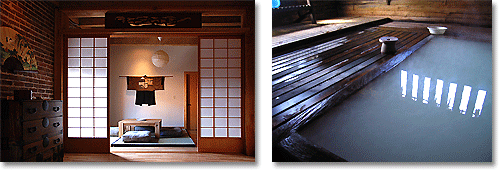
Zen interior design: Left: Japanese-inspired loft in in Denver, CO (USA); © Peter Batty
Right: Traditional Japanese hot tub, Kyushu (Japan); © Samuel Bietenholz
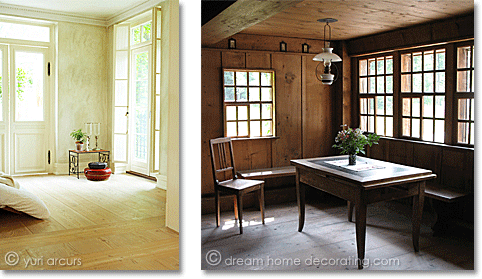
Zen interior design: Left - an apartment in Denmark with small Asian touches;
right - a traditional farmhouse sitting-room in Switzerland
These last two examples of decorating Zen style are both pretty extreme (to illustrate the point ;-)
Both rooms look clear and clutter-free. If you find the look a bit too bare, you could easily take the austere edge off without losing the Zen 'spirit'. For example, soften the Swiss room by adding loads of (solid-color) seat cushions, and hang those tall Scandinavian windows with simple, long creamy linen or cheesecloth curtains.
Notice how in both rooms, the decorative elements really stand out against the low-key background? Zen design makes you choose your decor wisely.
Take-home rule:
Any style that is not ornate or frilly can work for Zen home decor. If you pare it down enough to fit the above list of Zen design criteria, you'll be fine.
Now, if you're here for some insights into strictly traditional Japanese interiors, here's a glimpse into a traditional Japanese house:
In the next video, the owner of a traditional Japanese house near Kyoto gives a guided tour through some of the rooms of her home:
More About Zen Interior Design:
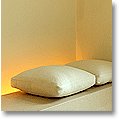
Zen Decorating
The Basics:
The page about Zen Decorating shows the basic elements of this style:
♦ How to simplify your decor easily;
♦ How to integrate art and nature;
♦ What types of wall art & colors to use (with lots of examples), and
♦ How to think about 'Zen furniture'.
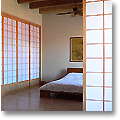
Zen Bedroom
Design
How To Sleep, Zen Style:
The article on Zen Bedroom Design is about the characteristics of non-Japanese Zen style bedrooms - sparsely furnished, serene 'contemporary Zen' interiors that are clutter free and painted in soothing neutral, earthy, or 'watery' colors.
If you're after the Japanese version, check out the Japanese Bedroom page; it has traditional as well as contemporary Japanese bedroom examples. In a washitsu (a traditional Japanese-style room), you simply spread your bedding (futon) directly onto a Tatami Floor Mat.
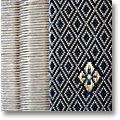
Tatami
Floor Mat
Many contemporary Japanese homes have adopted a style mix of old and new: There's often one traditional room - for ceremonies and for guests - and the rest of the living space looks quite Western, with a few colorful Japanese design touches.
For 'hybrid' bedrooms with a Japanese touch, head to the page about Asian Inspired Bedrooms. And finally, for non-Japanese, non-Zen, Asian Theme Bedroom decorating ... just click the link :-)
Zen Interior Design: Good Reads
If you would like to add a traditional Japanese touch to your home, check out this treasure trove of inspiration (Mini-Shop in partnership with Amazon):
For non-Japanese Zen home decor ideas, you can't go wrong with books from this collection:
Oh, and just in case you're curious about Zen, meditation, and spirituality, here are some books I have found very useful and inspiring:
- Eckhart Tolle, The Power of Now (2001)
- Jon Kabat-Zinn, Full Catastrophe Living (1996)
- Shunryu Suzuki, Zen Mind, Beginner's Mind (1970 - a classic, usually available second-hand at Amazon)
Have a browse ... Enjoy!
- Japanese Bedroom design, or: How to sleep on a Tatami Floor Mat
- Creating A Zen Look:
How To Organize Clutter
- Using Color In Zen Interiors:
Neutral Color Schemes - The Book:
Neutral color palettes are a perfect fit for zen interior design, but they're not as straightforward as many people think. Understand what makes neutral color schemes look their best, and what happens when you mix neutral color palettes with more saturate decorating colors. It's FREE!! -
Understand Interior Design Styles:
a) Interior Design Styles List
b) Interior Decorating: Style vs. Fashion
